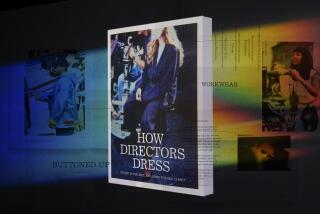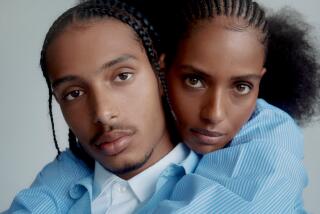The Picture of Innocence? : A defendant who uses clothes and other tricks to appear harmless may sway the jury, experts say. Michael Milken would have looked “more humble” without his toupee, for example, ad adark suit and long, loose hair were all wrong for Amy Fisher.
- Share via
Amy Fisher wore a dark suit to court, with her long brown hair parted in the middle, hanging slightly frizzy around her face.
Wrong, wrong, wrong, say experts in such matters.
“I would have put her in a French schoolgirl dress with a big collar, a dark color, ribbon in her hair, no makeup,” says Harry Munsinger, a San Antonio attorney and trial consultant. “Make her look as young and innocent as possible.”
And if Munsinger had been advising Mike Tyson, convicted of rape last year, he would have played down the boxer’s size and strength by dressing him in pastels and looser-fitting suits.
“I would have had him slump a little,” he says. (Tyson wore a dark gray suit and white shirt to court.)
Image experts and attorneys agree that, ultimately, evidence matters more than what a defendant wears. But, they say, why take chances?
“There’s no question, people respond emotionally before they respond intellectually, and we can use clothing as a tool to create the response we want,” says Jane Murdoch Miller, a Virginia-based image consultant.
“People like us can come in and help win a case just by changing the appearance of the clients. There are a lot of tricks in imaging.”
Take the case of Michael Milken. The junk-bond king, says Miller, would have had a better chance of winning if he had left his toupee behind during his trial.
“Without the hairpiece, he would have been perceived as more humble, more forthcoming, rather than wearing something that camouflages his appearance,” says Miller, who consulted on high-profile criminal cases in Canada before coming to this country in 1991.
“Because the judge was a woman, it makes even more of a difference,” she says. “Women do not like hairpieces.”
Psychologists at Jury Behavior Research Inc. in Los Angeles conduct witness workshops and charge lawyers and their clients $115 an hour for advice about everything from dress, to body language, to speech patterns.
“Little things don’t affect the jury that much,” says Wendy Pluta, a psychologist with the company. “But if there are enough of them, it could.”
In their desire to use those “little things” to their advantage, consultants and lawyers have learned to employ a number of subtle and not-so-subtle tactics.
Miller says it’s not uncommon for lawyers to spray a potentially shifty-eyed defendant’s glasses with PAM cooking spray--or do the same to a phony pair of glasses--so the jury cannot see the person’s eyes.
“Studies show people have a harder time remembering what was said, even if it was incriminating, if you can’t see the person’s eyes,” she says.
Clothing fit is another commonly used tool of perception manipulation.
Patty Hearst wore clothes a couple of sizes too large to make her look frail and emphasize her victim role, says Welds, who has a doctorate in psychology and specializes in forensic consulting.
Judges, most of whom have the power to decide what is or is not appropriate dress in their courtroom, agree that court attire is important.
Judge Bernard J. Kamins, who presided over the Rodney King case before it was moved to Simi Valley, as well as the initial Reginald Denny case, says he tries to impress upon jurors that the dress and appearance of plaintiffs and defendants is irrelevant. But, he says, juries can be easily affected when defendants appear in jail clothes.
“Jail clothes can cut two ways,” says Kamins, who has been a criminal-court judge for eight years. “It can hurt the defendant, because the jury figures if he has jail clothes on, he must have done something wrong. Or it can give sympathy to the defendant, and the jury has a natural inclination to feel some pity.”
Kamins keeps an ample supply of his own clothes in the courtroom closet for those who are coming from jail and don’t have something to wear.
“I think it’s important to have (defendants) dressed in appropriate, civilian clothes,” he says. “It allows them to feel good about themselves.”
Kamins says he is unaffected by trial participants’ dress. But other judges admit they can be swayed by the taste and appearance of those who come before them.
“Nobody can be unaffected by the appearance--which includes dress, behavior and hygiene--of a person who appears before him,” says a Los Angeles judge who asked not to be identified.
“Certain men appear before me who don’t shave. This is supposed to look pathetic. But it just makes them look unkempt. Some come in poorly dressed, in unmatched clothes and uncombed hair, to show how disoriented or dysfunctional they are.
“Though I have to put any negative feelings about a person’s appearance aside, it can be annoying. It never has no effect.”
Eric and Lyle Menendez, the handsome, wealthy brothers on trial for the killing their parents, changed their attire radically between early court appearances and later ones--from dark suits to pastel V-neck sweaters. That, experts say, is a good strategy.
“It’s good to start them in suits, to show respect for the proceedings,” Pluta says. “But then it’s good to put them in nice comfortable sweaters, rather than continuing a starchy tailored appearance--it helps them be perceived with a boy-next-door kind of image.”
Attorney Gloria Allred says she always suggests that her clients wear to court what they would wear to church. She warns against anything “low-cut, too tight or too short,” or clothing that is obviously expensive.
“If Anita Hill had been a client, I would never have put her in short sleeves,” Miller says. “It’s important not to show skin when working with the opposite sex.”
Miller says the more a woman’s body is covered, the more respect men tend to feel toward her. Men, she says, are more likely to sexualize a woman, and therefore take her less seriously, if they see her skin. “To dress to get equal respect from men, you need to keep flesh covered,” she says.
Defying all gender categories was the Massachusetts case earlier this year of the convicted wife killer and self-proclaimed “transsexual in transition,” Robert J. Kosilek.
After assuring the judge that he would dress “tastefully,” Kosilek, a.k.a. Michelle, was permitted to wear women’s clothes during his trial. The defendant was found guilty and sentenced to life in prison without parole.
Did Kosilek’s preference for petticoats affect the outcome of his trial?
“It could have an adverse affect on the mainstream juror,” Welds says. “It could be hard for jurors to concentrate on the content of the trial, if they’re wowed by the attire.”
“One never knows the subjective factors,” Allred says. “But why should anyone wake up thinking, ‘If only I had dressed a different way, I might not be serving a life term in prison?’ ”
More to Read
Sign up for Essential California
The most important California stories and recommendations in your inbox every morning.
You may occasionally receive promotional content from the Los Angeles Times.













